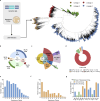Enhanced diagnosis of multi-drug-resistant microbes using group association modeling and machine learning
- PMID: 40133304
- PMCID: PMC11937555
- DOI: 10.1038/s41467-025-58214-6
Enhanced diagnosis of multi-drug-resistant microbes using group association modeling and machine learning
Abstract
New solutions are needed to detect genotype-phenotype associations involved in microbial drug resistance. Herein, we describe a Group Association Model (GAM) that accurately identifies genetic variants linked to drug resistance and mitigates false-positive cross-resistance artifacts without prior knowledge. GAM analysis of 7,179 Mycobacterium tuberculosis (Mtb) isolates identifies gene targets for all analyzed drugs, revealing comparable performance but fewer cross-resistance artifacts than World Health Organization (WHO) mutation catalogue approach, which requires expert rules and precedents. GAM also reveals generalizability, demonstrating high predictive accuracy with 3,942 S. aureus isolates. GAM refinement by machine learning (ML) improves predictive accuracy with small or incomplete datasets. These findings were validated using 427 Mtb isolates from three sites, where GAM inputs are also found to be more suitable in ML prediction models than WHO inputs. GAM + ML could thus address the limitations of current drug resistance prediction methods to improve treatment decisions for drug-resistant microbial infections.
© 2025. The Author(s).
Conflict of interest statement
Competing interests: The authors declare no competing interests.
Figures






Similar articles
-
Beyond multidrug resistance: Leveraging rare variants with machine and statistical learning models in Mycobacterium tuberculosis resistance prediction.EBioMedicine. 2019 May;43:356-369. doi: 10.1016/j.ebiom.2019.04.016. Epub 2019 Apr 29. EBioMedicine. 2019. PMID: 31047860 Free PMC article.
-
Accurate and rapid prediction of tuberculosis drug resistance from genome sequence data using traditional machine learning algorithms and CNN.Sci Rep. 2022 Feb 14;12(1):2427. doi: 10.1038/s41598-022-06449-4. Sci Rep. 2022. PMID: 35165358 Free PMC article.
-
Leveraging large-scale Mycobacterium tuberculosis whole genome sequence data to characterise drug-resistant mutations using machine learning and statistical approaches.Sci Rep. 2024 Nov 7;14(1):27091. doi: 10.1038/s41598-024-77947-w. Sci Rep. 2024. PMID: 39511309 Free PMC article.
-
Mutations associated with in vitro resistance to bedaquiline in Mycobacterium tuberculosis isolates in Australia.Tuberculosis (Edinb). 2018 Jul;111:31-34. doi: 10.1016/j.tube.2018.04.007. Epub 2018 Apr 25. Tuberculosis (Edinb). 2018. PMID: 30029911
-
Genotype analysis of ofloxacin-resistant multidrug-resistant Mycobacterium tuberculosis isolates in a multicentered study from India.Indian J Med Res. 2020 Apr;151(4):361-370. doi: 10.4103/ijmr.IJMR_493_18. Indian J Med Res. 2020. PMID: 32461400 Free PMC article.
Cited by
-
Extracellular Vesicles for Clinical Diagnostics: From Bulk Measurements to Single-Vesicle Analysis.ACS Nano. 2025 Aug 12;19(31):28021-28109. doi: 10.1021/acsnano.5c00706. Epub 2025 Jul 28. ACS Nano. 2025. PMID: 40720603 Free PMC article. Review.
References
MeSH terms
Substances
LinkOut - more resources
Full Text Sources

